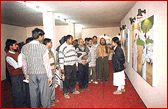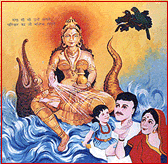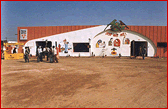Communication
Maha Kumbh Mela, Allahabad, 2001 – a media person's delight - the largest religious congregation in the world, where millions of devotees from all sections of the society, of all age groups, gather in a two-month long fete for a dip in the holy 'Sangam'. A dream come true for those seeking to communicate with the masses.
This opportunity that comes along once in twelve years, was not to be lost. SIFPSA hence set up an exhibition at the mela site to disseminate messages on health and family welfare.
The mela site was the hub of all activity in the city. Shops & essential services, entertainers, et al had sprung up, putting out their very best to cash in on this opportunity. The challenge here was to be able to attract visitors to a pavilion promoting something as mundane as family welfare amidst such fanfare. The effort therefore was to make the exhibits interesting and appealing. The design of the front fascia hence included attractively illustrated cut-outs of the SIFPSA multi-media campaign theme logo and other visuals propagating the theme - 'Come, Let's Talk' (Aao Baatein Karen). A large window cut-out in the centre of the fascia served as the nautanki (folk drama) performance stage visible from outside. This led to visitors flocking to the stall as soon as a performance started.
The nautanki performance alternated with a magic show on the same stage and a puppet performance visible from outside. Trained folk troupes in nautanki, magic and puppet performed on scripts that effectively merged entertainment with relevant messages on family welfare. Interiors of the stall were carefully designed to maintain the interest of visitors with a variety of media. A series of brightly illustrated panels conveyed simple messages on all issues related to the family – from gender equality, age at marriage to reproductive health and contraceptive methods. An interactive panel with messages on spacing contraceptives and a 'Tota Pundit' (puppet parrot – reading out fortunes) were very popular with the visitors. An added attraction on special bathing days was a live close-circuit video of the crowd inside the stall which was visible on a TV screen set up in a window of the fascia.
Trained animators were appointed to manage the exhibition, explain the messages to visitors as and when required and direct those seeking further information to the counselling room within the stall. A doctor and a trained counsellor present in the room advised such visitors and provided condoms and pills to those who required them. They made referrals to government hospitals for clinical services and also actively promoted no-scalpel vasectomy.
The month long exhibition successfully reached out to lakhs of visitors, with messages on reproductive health and family planning.
Other Links



Get in Touch with us
(Uttar Pradesh), INDIA
E-Mail : info@sifpsa.org
Phone :(91 - 0522) 2630902,997,741,896,899,894
Fax :
Site Manage by : MARG Software Solutions
2016 © SIFPSA All Rights Reserved
Number of Visitors

